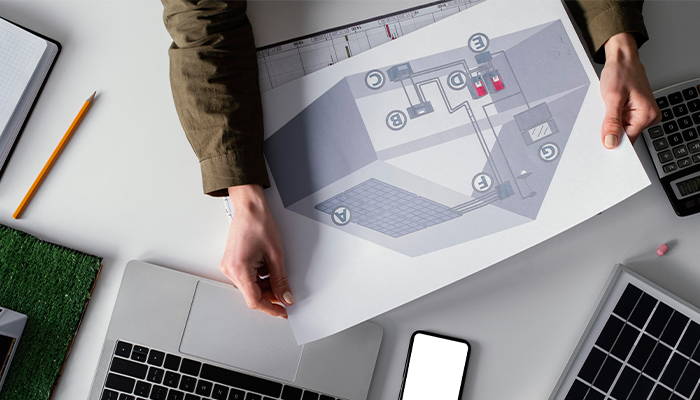The Cost of Developing Digital Asset Management (DAM) Software Like Brandfolder

APR, 22, 2024 17:30 PM
The Cost of Developing Digital Asset Management (DAM) Software Like Brandfolder
Digital Asset Management (DAM) software has become a crucial tool for businesses to organize, store, and share digital assets such as images, videos, documents, and creative files. Brandfolder is a prominent DAM platform known for its user-friendly interface, robust features, and customization options. If you're considering developing DAM software like Brandfolder, it's essential to understand the costs involved and the key factors that influence development. In this blog, we'll delve into the intricacies of developing DAM software and provide insights into the cost considerations.
Understanding Brandfolder and DAM Software:
Brandfolder is a cloud-based DAM platform designed to streamline digital asset management for brands, agencies, and marketing teams. It offers features such as asset organization, version control, metadata management, user permissions, collaboration tools, analytics, and integrations with other software solutions. DAM software like Brandfolder helps businesses maintain brand consistency, improve workflow efficiency, and enhance collaboration among teams.
Factors Influencing the Cost of DAM Software Development:
Features and Functionality:
- Asset Management:
- Organization and categorization of digital assets.
- Metadata management for searchability and tagging.
- Version control to track revisions and changes.
- User Management:
- User roles and permissions for access control.
- User-friendly interface for uploading, downloading, and sharing assets.
- Collaboration Tools:
- Collaboration features such as comments, annotations, and approvals.
- Workflow automation for asset review and approval processes.
- Integration Capabilities:
- Integration with other software systems such as content management systems (CMS), project management tools, design software, and social media platforms.
- APIs for custom integrations and data exchange.
- Analytics and Reporting:
- Data analytics to track asset usage, engagement metrics, and performance.
- Reporting tools for generating insights and optimizing asset management strategies.
Platform and Technology:
- Platform Selection:
- Web-based platform development for desktop browsers.
- Mobile app development for iOS and Android platforms (optional but beneficial for user convenience).
- Technology Stack:
- Frontend development using HTML/CSS, JavaScript frameworks (React, Angular, and Vue.js), and responsive design principles.
- Backend development with programming languages (Node.js, Python, PHP) and databases (MySQL, MongoDB) for data storage and retrieval.
- Cloud hosting and server infrastructure (AWS, Azure, Google Cloud) for scalability, security, and performance.
Design:
- UI/UX Design:
- User interface design for intuitive navigation, asset previews, search functionality, and user interactions.
- User experience design for seamless workflows, accessibility, and responsiveness across devices.
- Branding and Customization:
- Branding elements such as logos, color schemes, and custom themes.
- Customizable templates, layouts, and configurations to match client requirements.
Security and Compliance:
- Data Security:
- Encryption protocols (SSL/TLS) for secure data transmission.
- Access control measures, authentication mechanisms (SSO, LDAP), and audit logs.
- Compliance with data privacy regulations (GDPR, CCPA) and industry standards.
- Backup and Recovery:
- Regular data backups, disaster recovery plans, and data retention policies.
- Versioning and rollback capabilities for asset revisions and histories.
Testing and Quality Assurance:
- Functional Testing:
- Testing all features and functionalities to ensure they work as intended.
- User acceptance testing (UAT) is used to validate user workflows and usability.
- Performance Testing:
- Load testing to assess system performance under varying loads and user concurrency.
- Stress testing to identify bottlenecks, optimize performance, and ensure scalability.
- Security Testing:
- Vulnerability assessments, penetration testing, and security audits to identify and mitigate security risks.
- Compliance testing to ensure adherence to security standards and best practices.
Deployment and Maintenance:
- Deployment:
- Deployment to production environments, cloud platforms, and mobile app stores.
- Configuration management, release management, and deployment automation.
- Maintenance:
- Ongoing maintenance, updates, and bug fixes are needed to address issues, enhance features, and improve performance.
- Customer support, training, and documentation for users and administrators.
Let's delve deeper into specific aspects related to developing DAM software like Brandfolder and explore additional considerations regarding cost and implementation.
Advanced Features and Customization:
1.1 Workflow Automation:
- Implementing workflow automation features such as approval processes, notifications, and task assignments can enhance productivity and streamline asset management workflows. Costs for developing these functionalities may vary based on complexity and customization requirements.
1.2 Advanced Analytics and Insights:
- Integrating advanced analytics tools for tracking asset performance, user engagement, content usage trends, and ROI metrics can provide valuable insights for strategic decision-making. Costs for analytics integration and customization depend on the depth of analytics required and data visualization capabilities.
1.3 AI and machine learning:
- Leveraging artificial intelligence (AI) and machine learning (ML) algorithms for content tagging, auto-tagging, metadata generation, and smart recommendations can improve searchability, content discovery, and the user experience. Development costs for AI/ML features vary based on algorithm complexity, training data, and integration efforts.
1.4 Customization and White-Labeling:
- Offering customization options and white-labeling capabilities to clients for branding, UI/UX customization, and feature customization can add value and flexibility to the DAM software. Costs for customization and white-labeling depend on the level of customization required and client-specific branding needs.
Integration Ecosystem:
2.1 API Integration:
- Developing robust APIs (application programming interfaces) for seamless integration with third-party applications, platforms, and services (e.g., CRM systems, design tools, marketing automation software) enhances interoperability and expands the software's utility. Costs for API development, documentation, and testing should be factored into the overall development budget.
2.2 Content Sync and Migration:
- Providing tools and services for content synchronization, data migration, and bulk asset uploads from existing systems or cloud storage solutions can facilitate onboarding and adoption for clients with existing asset repositories. Costs for content migration tools and services depend on data volume, complexity, and migration strategy.
2.3 Single Sign-On (SSO) and LDAP Integration:
- Implementing single sign-on (SSO) functionality and LDAP (Lightweight Directory Access Protocol) integration for centralized user authentication, access management, and security compliance can enhance the user experience and administrative control. Costs for SSO/LDAP integration depend on identity provider compatibility and security requirements.
Scalability and Performance:
3.1 Scalability Planning:
- Designing and implementing scalable architecture, database optimization, caching mechanisms, and load balancing strategies ensure the software can handle increasing data volumes, user traffic, and concurrent user sessions. Costs for scalability planning and infrastructure optimization depend on anticipated growth projections and performance benchmarks.
3.2 Content Delivery Networks (CDNs):
- Leveraging content delivery networks (CDNs) for accelerated content delivery, global accessibility, and reduced latency can improve the user experience, especially for geographically distributed users. Costs for CDN integration and usage depend on data transfer volumes and CDN service providers.
Training and documentation:
4.1 User Training and Onboarding:
- Providing comprehensive user training materials, tutorials, video guides, and onboarding sessions for administrators, content managers, and end-users ensures smooth adoption and effective utilization of the DAM software. Costs for training and onboarding services may vary based on training delivery methods and content complexity.
4.2 Technical Documentation:
- Developing technical documentation, user manuals, API documentation, and support guides for reference, troubleshooting, and self-service support enhances user autonomy and reduces support overhead. Costs for technical documentation depend on content depth, formatting, and localization requirements.
Regulatory Compliance and Security Enhancements:
5.1 Data Governance and Compliance:
- Ensuring regulatory compliance with data privacy laws (e.g., GDPR, CCPA), industry standards (e.g., ISO 27001), and client-specific data governance policies requires robust data security measures, encryption protocols, access controls, audit trails, and compliance reporting functionalities. Costs for compliance and security enhancements depend on regulatory requirements and security audit findings.
5.2 Continuous Security Monitoring:
- Implementing continuous security monitoring, vulnerability assessments, penetration testing, and security incident response protocols helps mitigate security risks, detect threats, and ensure data protection. Costs for security monitoring tools, services, and compliance audits should be considered for ongoing security management.
Support and Maintenance:
6.1 Technical Support Services:
- Offering ongoing technical support services, helpdesk support, ticketing systems, and SLA-based support agreements ensures timely issue resolution, bug fixes, software updates, and customer satisfaction. Costs for technical support depend on support tiers, response times, and support channels (e.g., email support, phone support, live chat).
6.2 Software Updates and Upgrades:
- Providing regular software updates, feature enhancements, bug fixes, and version upgrades based on user feedback, industry trends, and technological advancements maintains software relevance, competitiveness, and user engagement. Costs for updates and upgrades should be factored into the ongoing maintenance budget.
Cost Breakdown:

The cost of developing DAM software like Brandfolder can vary widely based on project scope, features, technology stack, design complexity, security requirements, testing efforts, deployment strategies, and ongoing maintenance. Here's a rough breakdown of potential costs:
- Platform Development:
- Web-Based Platform: $50,000-$100,000.
- Mobile App Development (iOS/Android): $30,000-$50,000 per platform
- Features and Functionality:
- Basic Features (Asset Management, User Roles, Collaboration): $20,000-$40,000
- Advanced Features (Workflow Automation, Analytics, Integrations): $30,000-$60,000
- Design:
- UI/UX Design: $15,000-$30,000
- Branding and Customization: $10,000–$20,000
- Platform and Technology:
- Technology Stack: $20,000-$40,000
- Cloud Hosting and Infrastructure: $10,000-$20,000
- Security and Compliance:
- Security Measures: $15,000-$30,000
- Compliance Requirements: Varies based on specific regulations
- Testing and Quality Assurance:
- Testing Efforts: $15,000-$30,000
- Security Testing: $10,000-$20,000
- Deployment and Maintenance:
- Deployment Costs: $5,000-$10,000
- Ongoing Maintenance (Annual): 20–25% of the total development cost per year
Conclusion
Developing DAM software like Brandfolder requires a strategic approach, collaboration between multidisciplinary teams, and a comprehensive understanding of client needs, industry standards, and technological capabilities. By factoring in advanced features, customization options, integration ecosystem, scalability considerations, regulatory compliance, security enhancements, training and documentation services, and ongoing support and maintenance, businesses can create a robust and market-leading DAM solution that addresses evolving digital asset management challenges. Working with experienced software development partners, leveraging agile methodologies, and prioritizing user feedback can optimize development efforts, mitigate risks, and ensure the success of the DAM software in meeting client expectations and industry demands.




Strategy
Design
Blockchain Solution
Development
Launching
Testing
Maintenance
Contact US!
India

Plot 378-379, Udyog Vihar Phase 4 Rd, near nokia building, Electronic City, Phase IV, Sector 19, Gurugram, Haryana 122015
Copyright © 2025 PerfectionGeeks Technologies | All Rights Reserved | Policy
Strategy
Design
Blockchain Solution
Development
Contact US!
India 
Plot 378-379, Udyog Vihar Phase 4 Rd, near nokia building, Electronic City, Phase IV, Sector 19, Gurugram, Haryana 122015
USA 
1968 S. Coast Hwy, Laguna Beach, CA 92651, United States
Copyright © 2025 PerfectionGeeks Technologies | All Rights Reserved | Policy
